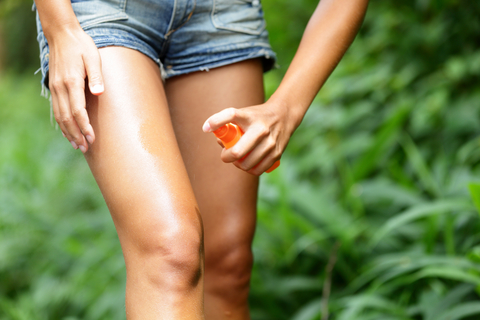Australia has seen an increasing number of dengue notifications in recent years – the more-than-2,000 confirmed cases reported last year were the highest in 20 years. Of the 2129 notifications, around 1 in 4 were in adults aged between 25 and 34 years. So we are asking - Are Australian travellers putting themselves at risk because of the Aussie ‘you’ll be right, mate’ mind-set, or is it due to the YOLO (you only live once) attitudes of younger travellers? Or could it be a lack of awareness which is fuelling this increase in infection rates?
In a survey carried out on over 1,000 Australian travellers by the pharmaceutical company Sanofi, 40% of them admitted to a YOLO attitude when travelling. The survey also exposed a lack of homework before eating food from street vendors and security lapses through falling asleep outdoors. What’s more, over 40 % of travellers said they did get sick, 50% didn’t have the recommended vaccinations and more than 60% didn’t consult their GP or a travel medicine specialist clinic prior to travel!
But back to dengue fever…
Dr Cameron Webb, University of Sydney-based medical entomologist and clinical lecturer, said recently that ‘dengue fever cases were increasing globally and travellers are bringing the disease back to Australia’ as a result. Unfortunately, many popular holiday destinations are also prone to outbreaks of dengue. The opportunities to be infected are most certainly there: In June last year, there were 824,300 short-term resident departures from Australia and many of the top 10 tourist destinations (Indonesia, Thailand, Singapore, Fiji and India) are dengue endemic countries. Western Australia was in number one spot across the country last year with 533 dengue notifications - maybe that’s because cheap air fares to (dengue-affected) Bali make it a popular travel destination.
Dengue, like other mosquito-borne diseases caused by Zika and chikungunya viruses, is transmitted by Aedes aegypti and Aedes albopictusmosquitoes. The mosquito vectors are both aggressive day-time feeders that breed and bite in urban locations and prefer cool, shaded places. They are found in areas close to people, their favourite source of the blood meal the females need to lay eggs.
While only about 25% of people infected with dengue viruses actually get symptoms, those that do fall ill can experience fever, headache, pain behind the eyes, rash, and severe aching of muscles, joints, and bones (and this is the reason why dengue also has another more evocative name, ‘breakbone fever’).
Dengue isn’t just a problem for travellers, it’s one of the most significant mosquito-borne viral diseases globally with a worldwide public health burden estimated at around 50 to 390 million infections, including dengue fever and the potentially fatal dengue haemorrhagic fever (DHF) and dengue shock syndrome (DSS). The mounting disease presence across the globe is believed to be due to climate change, the expansion of dengue vectors to new geographic regions, increasing human movement across borders, global trade and urban migration.
Our advice to avoid dengue?
Before you ask, there isn’t a dengue vaccine ... or at least not yet for tourists. A vaccine has been developed and is currently registered in 11 countries – but they are all countries with a significant dengue burden, and this is where the vaccine will be most useful. It is expected to reduce the levels of severe dengue illness and the resulting hospitalisations through its actions in the 9 to 45 years age group.
For many travellers staying at major resorts, there will be mosquito control programs in place that substantially reduce the risks of dengue. Perhaps this is why fewer older Australian travellers are returning infected with dengue. However, even if staying in a resort with minimal risk, be aware that day trips to local villages or towns may bring with them a risk of exposure to mosquitoes, so take steps to avoid these bites.
Minimise mosquito bites and you reduce the risk of infection
Dr Webb says Australian travellers can reduce their risk of being bitten by following these measures:
– The mosquitoes that spread dengue viruses bite during the day. This means travellers must be actively avoiding mosquito bites during the day, not just in the afternoon and evening. Wearing loose, long-sleeved shirts and long pants outdoors together with topical insect repellents will provide the best protection.
–The most effective insect repellents are those containing DEET, Picaridin or extract of lemon eucalyptus oil. It is always best to take insect repellent with you from Australia as it may be difficult to find suitable formulations at your holiday destination. See here for the range of repellents that Travelvax stocks.
– Where possible, ensure where you’re staying is air conditioned and has screened windows and doors.
– Get rid of any standing water around your accommodation, including pot plant bases and other containers that collect water.
– If you are using sunscreen, apply it first BEFORE your insect repellent.
– If you’re likely to be consistently exposed to insect bites, soak your clothing and bed net (if your room is not screened) with permethrin. This contact insecticide repels mosquitoes and other insects, and also kills them when they come in contact with the treated material. (Permethrin shouldn’t be applied directly to your skin.) Read more about permethrin and how to protect yourself against insect bites.
– Mosquito coils and “plug-in” devices can also assist in reducing mosquito bites around your accommodation
The fewer times you get bitten, the lower the risk of infection. Don’t get bitten and there’s absolutely no chance at all.
No excuse for the lack of awareness now.
Did you know you can get no-obligation, country-specific advice on insect-borne diseases and other potential health risks of your next overseas destination by calling Travelvax Australia’s travel health advisory service on 1300 360 164 (free to landlines)?

